Consumer Behaviour and Insight Project: Decision Making Analysis
VerifiedAdded on 2020/11/12
|10
|2657
|314
Project
AI Summary
This project report examines consumer behavior and insights within the context of Ragus Sugars, a UK-based sugar syrup and sugar manufacturer. It delves into the stages of consumer decision-making, exploring various models like economic, passive, cognitive, and emotional models. The report highlights the importance of mapping the path to purchase and understanding consumer decision-making processes for effective marketing. Factors influencing consumer behavior, including cultural, psychological, personal, marketing mix, social, economical, and functional aspects are discussed. The project also outlines the decision-making process, from need recognition to purchase evaluation, offering insights for marketers to better understand and cater to consumer needs. The report emphasizes the significance of analyzing consumer preferences and providing products that meet consumer expectations to achieve business objectives and foster brand loyalty.
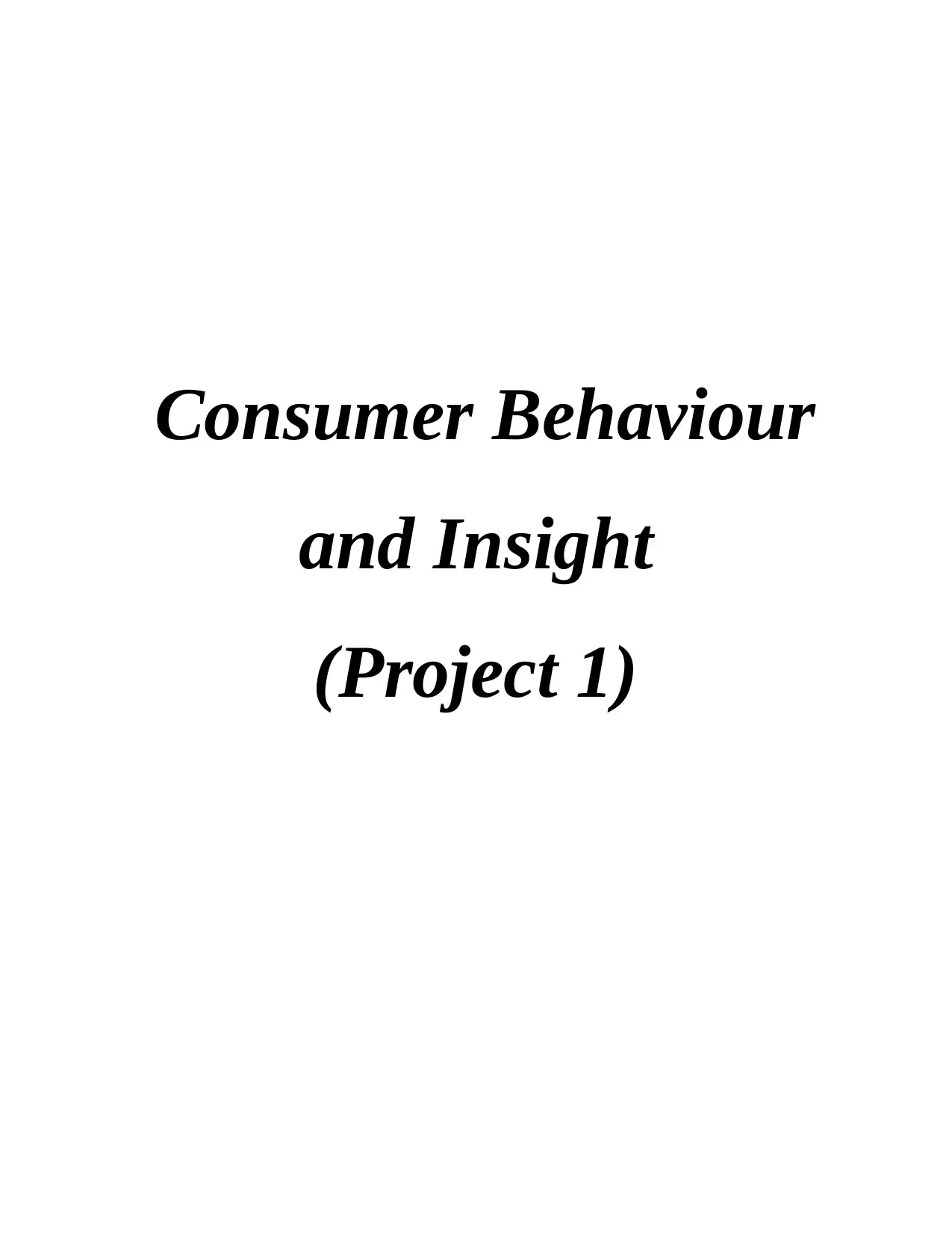
Consumer Behaviour
and Insight
(Project 1)
and Insight
(Project 1)
Paraphrase This Document
Need a fresh take? Get an instant paraphrase of this document with our AI Paraphraser
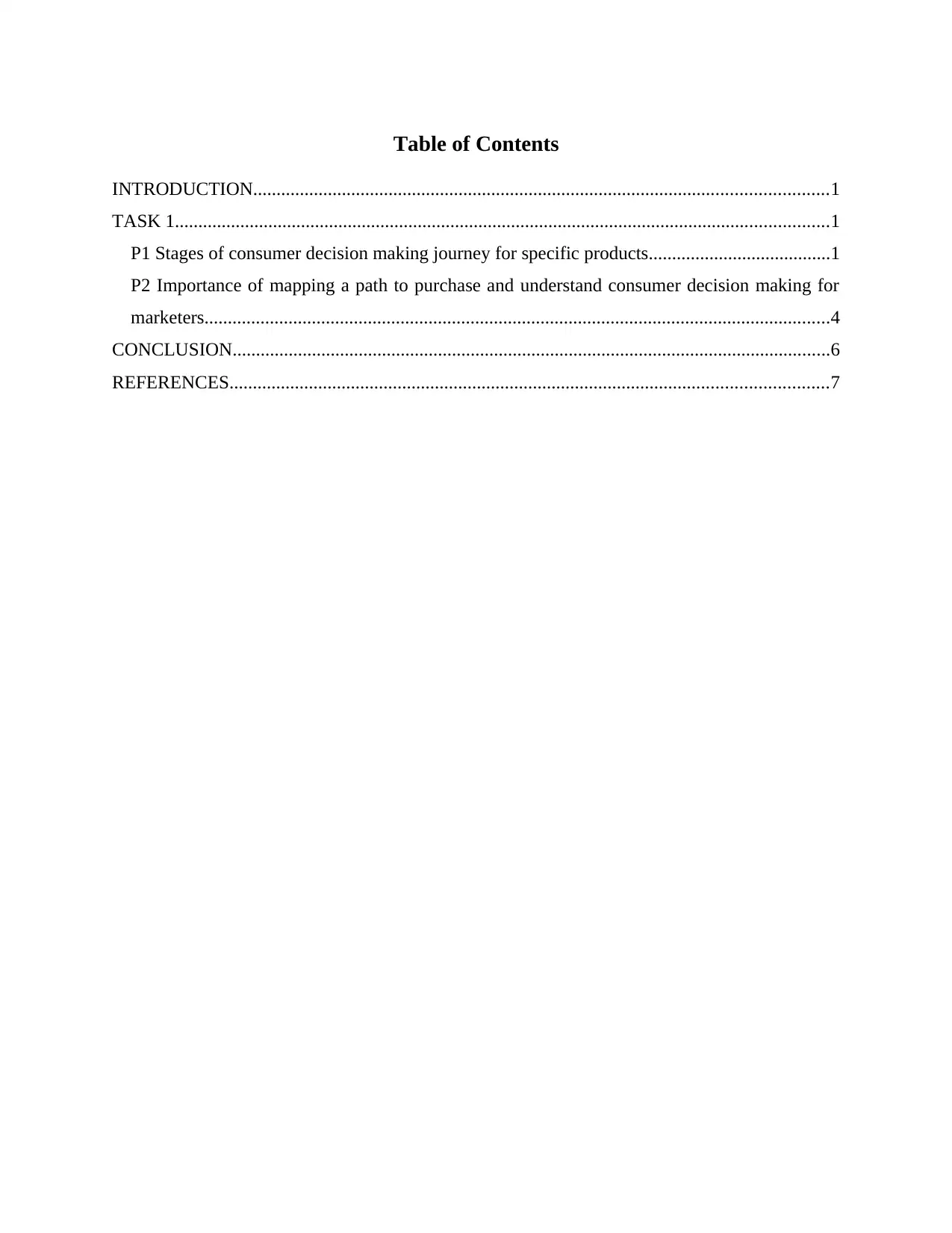
Table of Contents
INTRODUCTION...........................................................................................................................1
TASK 1............................................................................................................................................1
P1 Stages of consumer decision making journey for specific products.......................................1
P2 Importance of mapping a path to purchase and understand consumer decision making for
marketers......................................................................................................................................4
CONCLUSION................................................................................................................................6
REFERENCES................................................................................................................................7
INTRODUCTION...........................................................................................................................1
TASK 1............................................................................................................................................1
P1 Stages of consumer decision making journey for specific products.......................................1
P2 Importance of mapping a path to purchase and understand consumer decision making for
marketers......................................................................................................................................4
CONCLUSION................................................................................................................................6
REFERENCES................................................................................................................................7

⊘ This is a preview!⊘
Do you want full access?
Subscribe today to unlock all pages.

Trusted by 1+ million students worldwide
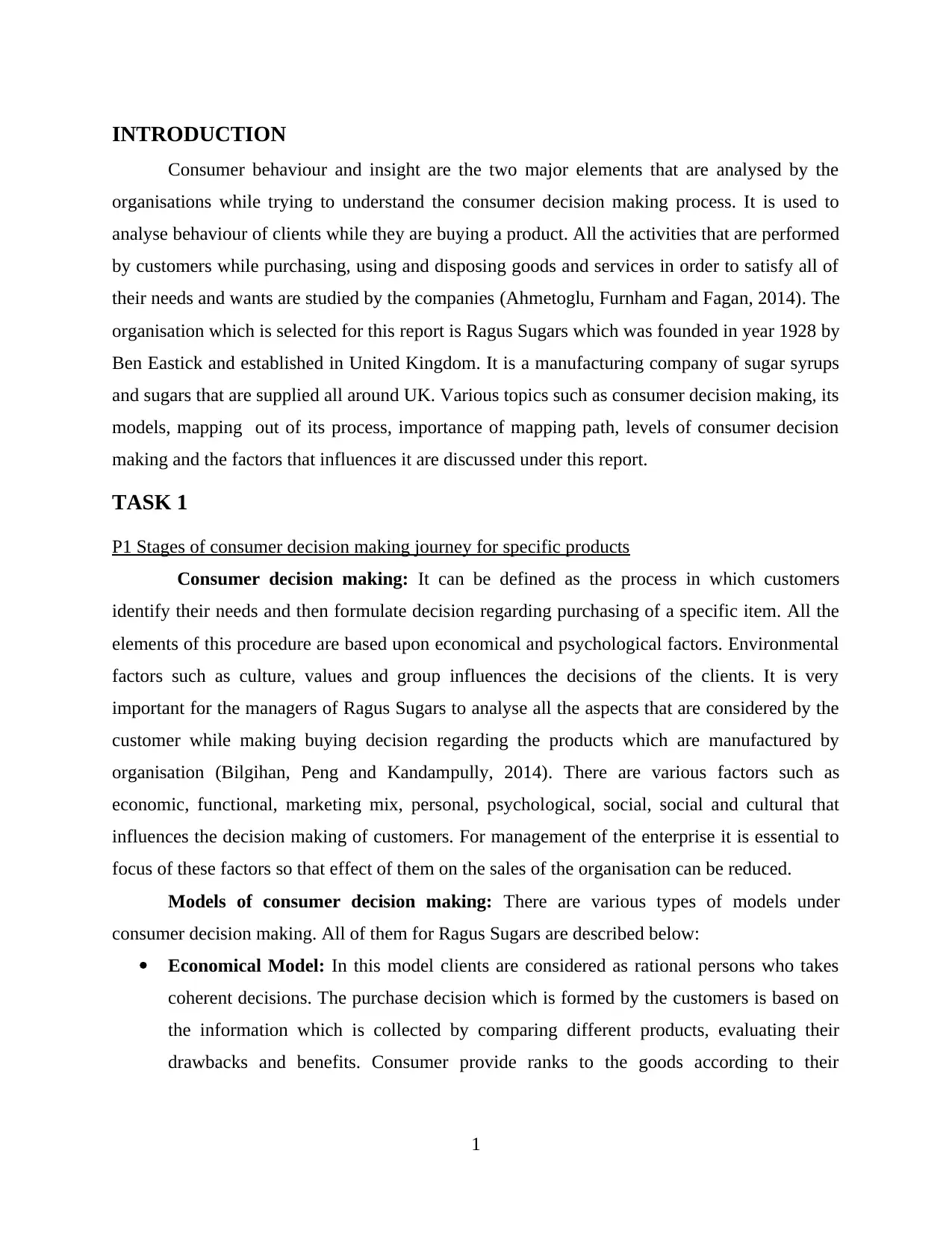
INTRODUCTION
Consumer behaviour and insight are the two major elements that are analysed by the
organisations while trying to understand the consumer decision making process. It is used to
analyse behaviour of clients while they are buying a product. All the activities that are performed
by customers while purchasing, using and disposing goods and services in order to satisfy all of
their needs and wants are studied by the companies (Ahmetoglu, Furnham and Fagan, 2014). The
organisation which is selected for this report is Ragus Sugars which was founded in year 1928 by
Ben Eastick and established in United Kingdom. It is a manufacturing company of sugar syrups
and sugars that are supplied all around UK. Various topics such as consumer decision making, its
models, mapping out of its process, importance of mapping path, levels of consumer decision
making and the factors that influences it are discussed under this report.
TASK 1
P1 Stages of consumer decision making journey for specific products
Consumer decision making: It can be defined as the process in which customers
identify their needs and then formulate decision regarding purchasing of a specific item. All the
elements of this procedure are based upon economical and psychological factors. Environmental
factors such as culture, values and group influences the decisions of the clients. It is very
important for the managers of Ragus Sugars to analyse all the aspects that are considered by the
customer while making buying decision regarding the products which are manufactured by
organisation (Bilgihan, Peng and Kandampully, 2014). There are various factors such as
economic, functional, marketing mix, personal, psychological, social, social and cultural that
influences the decision making of customers. For management of the enterprise it is essential to
focus of these factors so that effect of them on the sales of the organisation can be reduced.
Models of consumer decision making: There are various types of models under
consumer decision making. All of them for Ragus Sugars are described below:
Economical Model: In this model clients are considered as rational persons who takes
coherent decisions. The purchase decision which is formed by the customers is based on
the information which is collected by comparing different products, evaluating their
drawbacks and benefits. Consumer provide ranks to the goods according to their
1
Consumer behaviour and insight are the two major elements that are analysed by the
organisations while trying to understand the consumer decision making process. It is used to
analyse behaviour of clients while they are buying a product. All the activities that are performed
by customers while purchasing, using and disposing goods and services in order to satisfy all of
their needs and wants are studied by the companies (Ahmetoglu, Furnham and Fagan, 2014). The
organisation which is selected for this report is Ragus Sugars which was founded in year 1928 by
Ben Eastick and established in United Kingdom. It is a manufacturing company of sugar syrups
and sugars that are supplied all around UK. Various topics such as consumer decision making, its
models, mapping out of its process, importance of mapping path, levels of consumer decision
making and the factors that influences it are discussed under this report.
TASK 1
P1 Stages of consumer decision making journey for specific products
Consumer decision making: It can be defined as the process in which customers
identify their needs and then formulate decision regarding purchasing of a specific item. All the
elements of this procedure are based upon economical and psychological factors. Environmental
factors such as culture, values and group influences the decisions of the clients. It is very
important for the managers of Ragus Sugars to analyse all the aspects that are considered by the
customer while making buying decision regarding the products which are manufactured by
organisation (Bilgihan, Peng and Kandampully, 2014). There are various factors such as
economic, functional, marketing mix, personal, psychological, social, social and cultural that
influences the decision making of customers. For management of the enterprise it is essential to
focus of these factors so that effect of them on the sales of the organisation can be reduced.
Models of consumer decision making: There are various types of models under
consumer decision making. All of them for Ragus Sugars are described below:
Economical Model: In this model clients are considered as rational persons who takes
coherent decisions. The purchase decision which is formed by the customers is based on
the information which is collected by comparing different products, evaluating their
drawbacks and benefits. Consumer provide ranks to the goods according to their
1
Paraphrase This Document
Need a fresh take? Get an instant paraphrase of this document with our AI Paraphraser
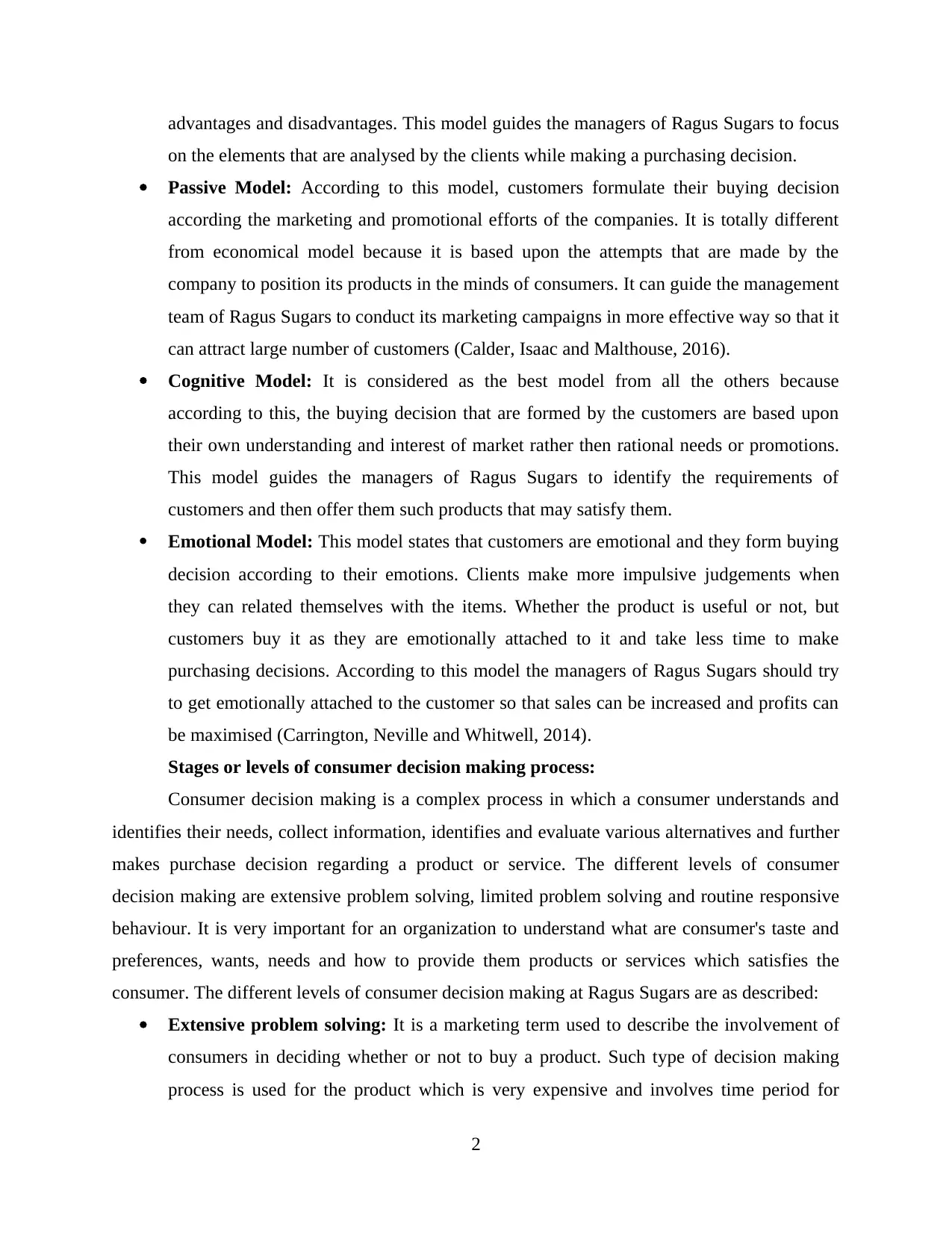
advantages and disadvantages. This model guides the managers of Ragus Sugars to focus
on the elements that are analysed by the clients while making a purchasing decision.
Passive Model: According to this model, customers formulate their buying decision
according the marketing and promotional efforts of the companies. It is totally different
from economical model because it is based upon the attempts that are made by the
company to position its products in the minds of consumers. It can guide the management
team of Ragus Sugars to conduct its marketing campaigns in more effective way so that it
can attract large number of customers (Calder, Isaac and Malthouse, 2016).
Cognitive Model: It is considered as the best model from all the others because
according to this, the buying decision that are formed by the customers are based upon
their own understanding and interest of market rather then rational needs or promotions.
This model guides the managers of Ragus Sugars to identify the requirements of
customers and then offer them such products that may satisfy them.
Emotional Model: This model states that customers are emotional and they form buying
decision according to their emotions. Clients make more impulsive judgements when
they can related themselves with the items. Whether the product is useful or not, but
customers buy it as they are emotionally attached to it and take less time to make
purchasing decisions. According to this model the managers of Ragus Sugars should try
to get emotionally attached to the customer so that sales can be increased and profits can
be maximised (Carrington, Neville and Whitwell, 2014).
Stages or levels of consumer decision making process:
Consumer decision making is a complex process in which a consumer understands and
identifies their needs, collect information, identifies and evaluate various alternatives and further
makes purchase decision regarding a product or service. The different levels of consumer
decision making are extensive problem solving, limited problem solving and routine responsive
behaviour. It is very important for an organization to understand what are consumer's taste and
preferences, wants, needs and how to provide them products or services which satisfies the
consumer. The different levels of consumer decision making at Ragus Sugars are as described:
Extensive problem solving: It is a marketing term used to describe the involvement of
consumers in deciding whether or not to buy a product. Such type of decision making
process is used for the product which is very expensive and involves time period for
2
on the elements that are analysed by the clients while making a purchasing decision.
Passive Model: According to this model, customers formulate their buying decision
according the marketing and promotional efforts of the companies. It is totally different
from economical model because it is based upon the attempts that are made by the
company to position its products in the minds of consumers. It can guide the management
team of Ragus Sugars to conduct its marketing campaigns in more effective way so that it
can attract large number of customers (Calder, Isaac and Malthouse, 2016).
Cognitive Model: It is considered as the best model from all the others because
according to this, the buying decision that are formed by the customers are based upon
their own understanding and interest of market rather then rational needs or promotions.
This model guides the managers of Ragus Sugars to identify the requirements of
customers and then offer them such products that may satisfy them.
Emotional Model: This model states that customers are emotional and they form buying
decision according to their emotions. Clients make more impulsive judgements when
they can related themselves with the items. Whether the product is useful or not, but
customers buy it as they are emotionally attached to it and take less time to make
purchasing decisions. According to this model the managers of Ragus Sugars should try
to get emotionally attached to the customer so that sales can be increased and profits can
be maximised (Carrington, Neville and Whitwell, 2014).
Stages or levels of consumer decision making process:
Consumer decision making is a complex process in which a consumer understands and
identifies their needs, collect information, identifies and evaluate various alternatives and further
makes purchase decision regarding a product or service. The different levels of consumer
decision making are extensive problem solving, limited problem solving and routine responsive
behaviour. It is very important for an organization to understand what are consumer's taste and
preferences, wants, needs and how to provide them products or services which satisfies the
consumer. The different levels of consumer decision making at Ragus Sugars are as described:
Extensive problem solving: It is a marketing term used to describe the involvement of
consumers in deciding whether or not to buy a product. Such type of decision making
process is used for the product which is very expensive and involves time period for
2
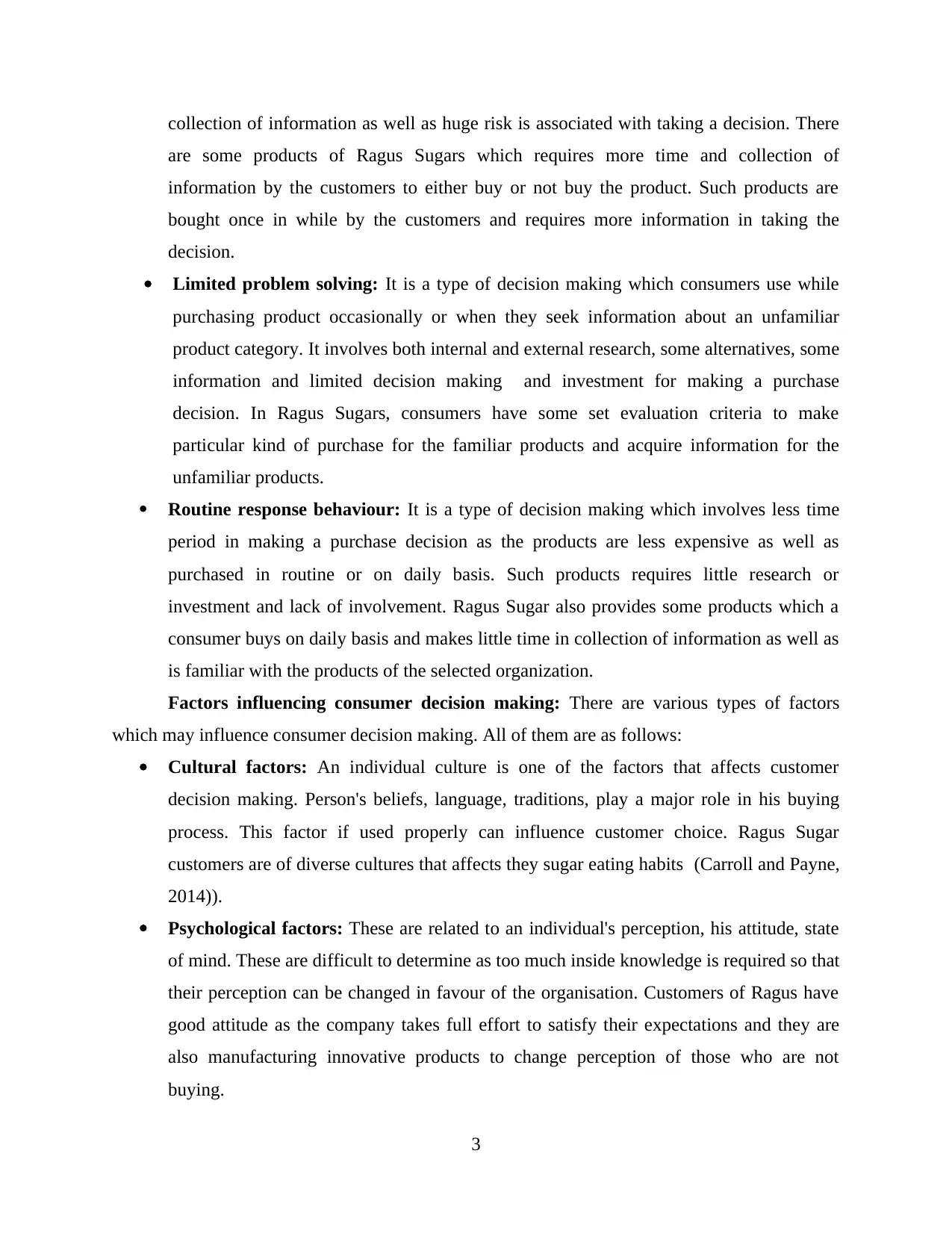
collection of information as well as huge risk is associated with taking a decision. There
are some products of Ragus Sugars which requires more time and collection of
information by the customers to either buy or not buy the product. Such products are
bought once in while by the customers and requires more information in taking the
decision.
Limited problem solving: It is a type of decision making which consumers use while
purchasing product occasionally or when they seek information about an unfamiliar
product category. It involves both internal and external research, some alternatives, some
information and limited decision making and investment for making a purchase
decision. In Ragus Sugars, consumers have some set evaluation criteria to make
particular kind of purchase for the familiar products and acquire information for the
unfamiliar products.
Routine response behaviour: It is a type of decision making which involves less time
period in making a purchase decision as the products are less expensive as well as
purchased in routine or on daily basis. Such products requires little research or
investment and lack of involvement. Ragus Sugar also provides some products which a
consumer buys on daily basis and makes little time in collection of information as well as
is familiar with the products of the selected organization.
Factors influencing consumer decision making: There are various types of factors
which may influence consumer decision making. All of them are as follows:
Cultural factors: An individual culture is one of the factors that affects customer
decision making. Person's beliefs, language, traditions, play a major role in his buying
process. This factor if used properly can influence customer choice. Ragus Sugar
customers are of diverse cultures that affects they sugar eating habits (Carroll and Payne,
2014)).
Psychological factors: These are related to an individual's perception, his attitude, state
of mind. These are difficult to determine as too much inside knowledge is required so that
their perception can be changed in favour of the organisation. Customers of Ragus have
good attitude as the company takes full effort to satisfy their expectations and they are
also manufacturing innovative products to change perception of those who are not
buying.
3
are some products of Ragus Sugars which requires more time and collection of
information by the customers to either buy or not buy the product. Such products are
bought once in while by the customers and requires more information in taking the
decision.
Limited problem solving: It is a type of decision making which consumers use while
purchasing product occasionally or when they seek information about an unfamiliar
product category. It involves both internal and external research, some alternatives, some
information and limited decision making and investment for making a purchase
decision. In Ragus Sugars, consumers have some set evaluation criteria to make
particular kind of purchase for the familiar products and acquire information for the
unfamiliar products.
Routine response behaviour: It is a type of decision making which involves less time
period in making a purchase decision as the products are less expensive as well as
purchased in routine or on daily basis. Such products requires little research or
investment and lack of involvement. Ragus Sugar also provides some products which a
consumer buys on daily basis and makes little time in collection of information as well as
is familiar with the products of the selected organization.
Factors influencing consumer decision making: There are various types of factors
which may influence consumer decision making. All of them are as follows:
Cultural factors: An individual culture is one of the factors that affects customer
decision making. Person's beliefs, language, traditions, play a major role in his buying
process. This factor if used properly can influence customer choice. Ragus Sugar
customers are of diverse cultures that affects they sugar eating habits (Carroll and Payne,
2014)).
Psychological factors: These are related to an individual's perception, his attitude, state
of mind. These are difficult to determine as too much inside knowledge is required so that
their perception can be changed in favour of the organisation. Customers of Ragus have
good attitude as the company takes full effort to satisfy their expectations and they are
also manufacturing innovative products to change perception of those who are not
buying.
3
⊘ This is a preview!⊘
Do you want full access?
Subscribe today to unlock all pages.

Trusted by 1+ million students worldwide
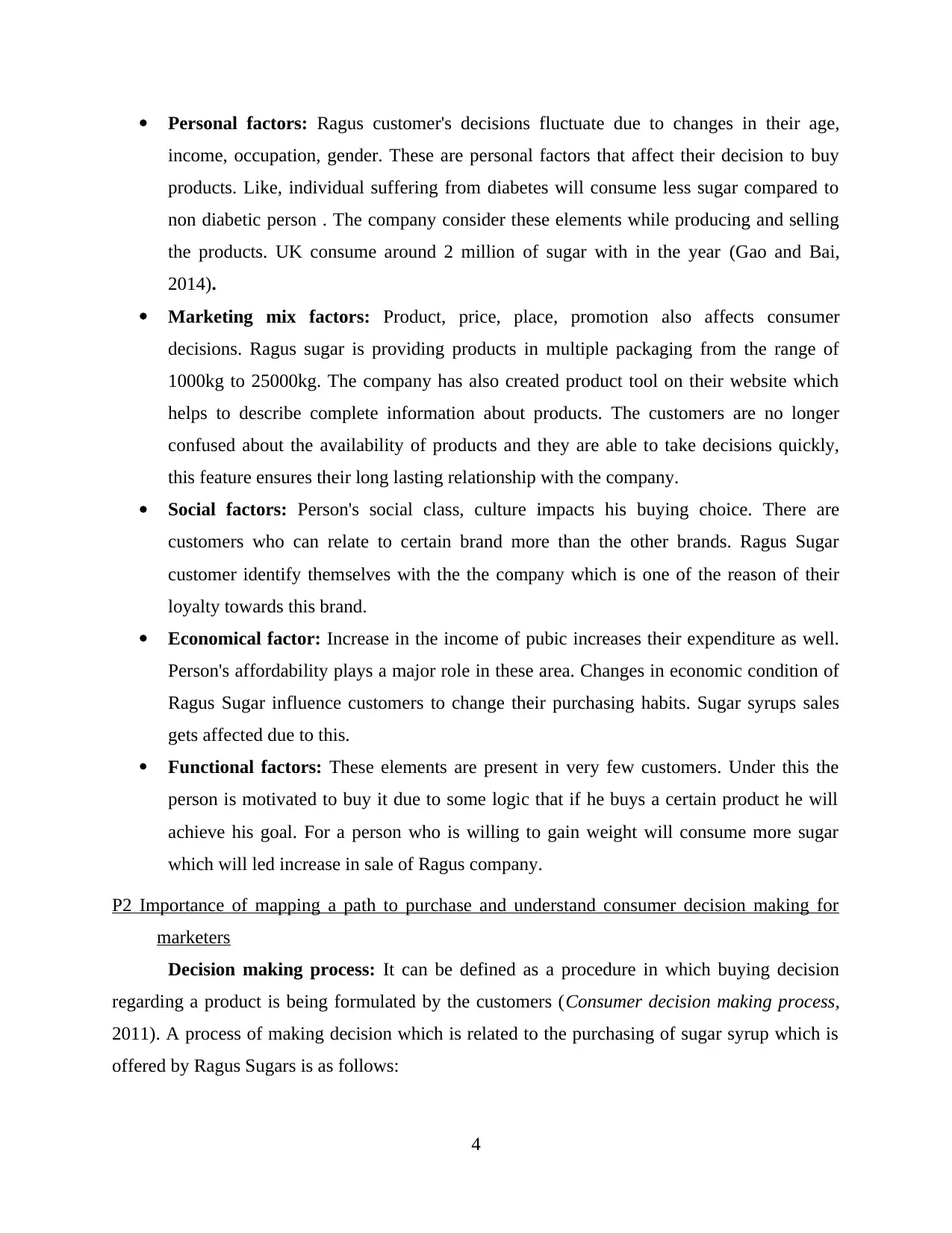
Personal factors: Ragus customer's decisions fluctuate due to changes in their age,
income, occupation, gender. These are personal factors that affect their decision to buy
products. Like, individual suffering from diabetes will consume less sugar compared to
non diabetic person . The company consider these elements while producing and selling
the products. UK consume around 2 million of sugar with in the year (Gao and Bai,
2014).
Marketing mix factors: Product, price, place, promotion also affects consumer
decisions. Ragus sugar is providing products in multiple packaging from the range of
1000kg to 25000kg. The company has also created product tool on their website which
helps to describe complete information about products. The customers are no longer
confused about the availability of products and they are able to take decisions quickly,
this feature ensures their long lasting relationship with the company.
Social factors: Person's social class, culture impacts his buying choice. There are
customers who can relate to certain brand more than the other brands. Ragus Sugar
customer identify themselves with the the company which is one of the reason of their
loyalty towards this brand.
Economical factor: Increase in the income of pubic increases their expenditure as well.
Person's affordability plays a major role in these area. Changes in economic condition of
Ragus Sugar influence customers to change their purchasing habits. Sugar syrups sales
gets affected due to this.
Functional factors: These elements are present in very few customers. Under this the
person is motivated to buy it due to some logic that if he buys a certain product he will
achieve his goal. For a person who is willing to gain weight will consume more sugar
which will led increase in sale of Ragus company.
P2 Importance of mapping a path to purchase and understand consumer decision making for
marketers
Decision making process: It can be defined as a procedure in which buying decision
regarding a product is being formulated by the customers (Consumer decision making process,
2011). A process of making decision which is related to the purchasing of sugar syrup which is
offered by Ragus Sugars is as follows:
4
income, occupation, gender. These are personal factors that affect their decision to buy
products. Like, individual suffering from diabetes will consume less sugar compared to
non diabetic person . The company consider these elements while producing and selling
the products. UK consume around 2 million of sugar with in the year (Gao and Bai,
2014).
Marketing mix factors: Product, price, place, promotion also affects consumer
decisions. Ragus sugar is providing products in multiple packaging from the range of
1000kg to 25000kg. The company has also created product tool on their website which
helps to describe complete information about products. The customers are no longer
confused about the availability of products and they are able to take decisions quickly,
this feature ensures their long lasting relationship with the company.
Social factors: Person's social class, culture impacts his buying choice. There are
customers who can relate to certain brand more than the other brands. Ragus Sugar
customer identify themselves with the the company which is one of the reason of their
loyalty towards this brand.
Economical factor: Increase in the income of pubic increases their expenditure as well.
Person's affordability plays a major role in these area. Changes in economic condition of
Ragus Sugar influence customers to change their purchasing habits. Sugar syrups sales
gets affected due to this.
Functional factors: These elements are present in very few customers. Under this the
person is motivated to buy it due to some logic that if he buys a certain product he will
achieve his goal. For a person who is willing to gain weight will consume more sugar
which will led increase in sale of Ragus company.
P2 Importance of mapping a path to purchase and understand consumer decision making for
marketers
Decision making process: It can be defined as a procedure in which buying decision
regarding a product is being formulated by the customers (Consumer decision making process,
2011). A process of making decision which is related to the purchasing of sugar syrup which is
offered by Ragus Sugars is as follows:
4
Paraphrase This Document
Need a fresh take? Get an instant paraphrase of this document with our AI Paraphraser

Need recognition: It is the first stage in which customers identify their need regarding
the product which is required by them to satisfy them. For example, if an individual has
recently opened a business in which it is offering different types of drinks and mock tails
to the customers. Then it will be analysed that the main requirement for the business is
sugar syrup which can be used to sweeten the items such as iced tea, lemonade etc.
(Source: Consumer decision making process, 2011)
Information search: When need is analysed then customer move of the second stage
which is gathering information regarding the products which is required by them. The
consumer analyses all the positive and negative aspects of items. While making decision
of buying sugar syrup the individual will find gather different information related to it
and then analyse advantages and disadvantages of the product (Gillingham and Palmer,
2014). It can be collected from different sources such as personal contacts, printed
sources, commercial information and previous experiences.
Evaluation of alternatives: When need is identified and appropriate information is being
collected then they look for different sellers who are selling same products. At this stage
various aspects are analysed by them such as price, quality, quantity and value added to
the product. The buyer of sugar syrup will identify different suppliers of it and then
analyse who is providing the best deal and product.
5
Illustration 1: Consumer decision making process, 2011
the product which is required by them to satisfy them. For example, if an individual has
recently opened a business in which it is offering different types of drinks and mock tails
to the customers. Then it will be analysed that the main requirement for the business is
sugar syrup which can be used to sweeten the items such as iced tea, lemonade etc.
(Source: Consumer decision making process, 2011)
Information search: When need is analysed then customer move of the second stage
which is gathering information regarding the products which is required by them. The
consumer analyses all the positive and negative aspects of items. While making decision
of buying sugar syrup the individual will find gather different information related to it
and then analyse advantages and disadvantages of the product (Gillingham and Palmer,
2014). It can be collected from different sources such as personal contacts, printed
sources, commercial information and previous experiences.
Evaluation of alternatives: When need is identified and appropriate information is being
collected then they look for different sellers who are selling same products. At this stage
various aspects are analysed by them such as price, quality, quantity and value added to
the product. The buyer of sugar syrup will identify different suppliers of it and then
analyse who is providing the best deal and product.
5
Illustration 1: Consumer decision making process, 2011
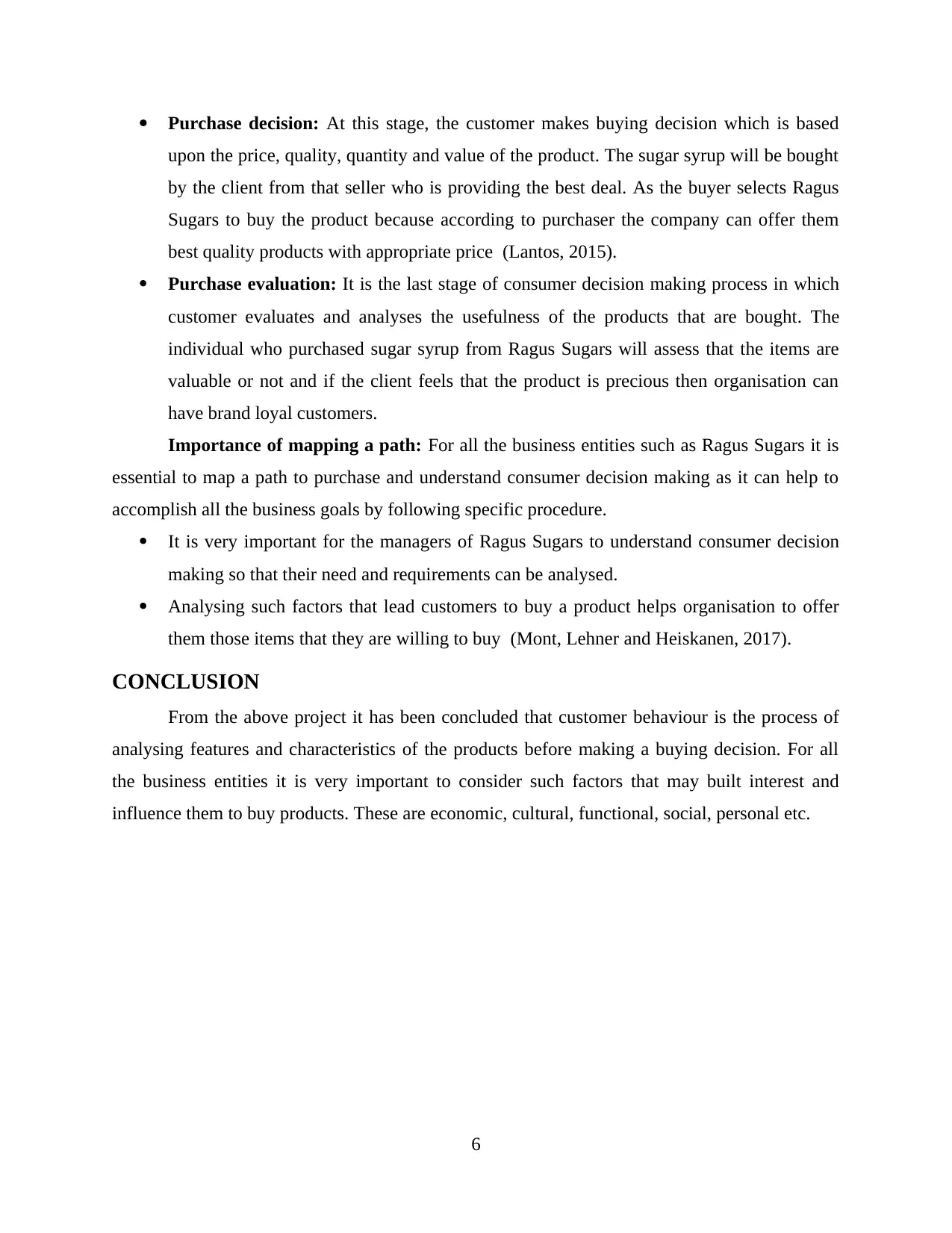
Purchase decision: At this stage, the customer makes buying decision which is based
upon the price, quality, quantity and value of the product. The sugar syrup will be bought
by the client from that seller who is providing the best deal. As the buyer selects Ragus
Sugars to buy the product because according to purchaser the company can offer them
best quality products with appropriate price (Lantos, 2015).
Purchase evaluation: It is the last stage of consumer decision making process in which
customer evaluates and analyses the usefulness of the products that are bought. The
individual who purchased sugar syrup from Ragus Sugars will assess that the items are
valuable or not and if the client feels that the product is precious then organisation can
have brand loyal customers.
Importance of mapping a path: For all the business entities such as Ragus Sugars it is
essential to map a path to purchase and understand consumer decision making as it can help to
accomplish all the business goals by following specific procedure.
It is very important for the managers of Ragus Sugars to understand consumer decision
making so that their need and requirements can be analysed.
Analysing such factors that lead customers to buy a product helps organisation to offer
them those items that they are willing to buy (Mont, Lehner and Heiskanen, 2017).
CONCLUSION
From the above project it has been concluded that customer behaviour is the process of
analysing features and characteristics of the products before making a buying decision. For all
the business entities it is very important to consider such factors that may built interest and
influence them to buy products. These are economic, cultural, functional, social, personal etc.
6
upon the price, quality, quantity and value of the product. The sugar syrup will be bought
by the client from that seller who is providing the best deal. As the buyer selects Ragus
Sugars to buy the product because according to purchaser the company can offer them
best quality products with appropriate price (Lantos, 2015).
Purchase evaluation: It is the last stage of consumer decision making process in which
customer evaluates and analyses the usefulness of the products that are bought. The
individual who purchased sugar syrup from Ragus Sugars will assess that the items are
valuable or not and if the client feels that the product is precious then organisation can
have brand loyal customers.
Importance of mapping a path: For all the business entities such as Ragus Sugars it is
essential to map a path to purchase and understand consumer decision making as it can help to
accomplish all the business goals by following specific procedure.
It is very important for the managers of Ragus Sugars to understand consumer decision
making so that their need and requirements can be analysed.
Analysing such factors that lead customers to buy a product helps organisation to offer
them those items that they are willing to buy (Mont, Lehner and Heiskanen, 2017).
CONCLUSION
From the above project it has been concluded that customer behaviour is the process of
analysing features and characteristics of the products before making a buying decision. For all
the business entities it is very important to consider such factors that may built interest and
influence them to buy products. These are economic, cultural, functional, social, personal etc.
6
⊘ This is a preview!⊘
Do you want full access?
Subscribe today to unlock all pages.

Trusted by 1+ million students worldwide
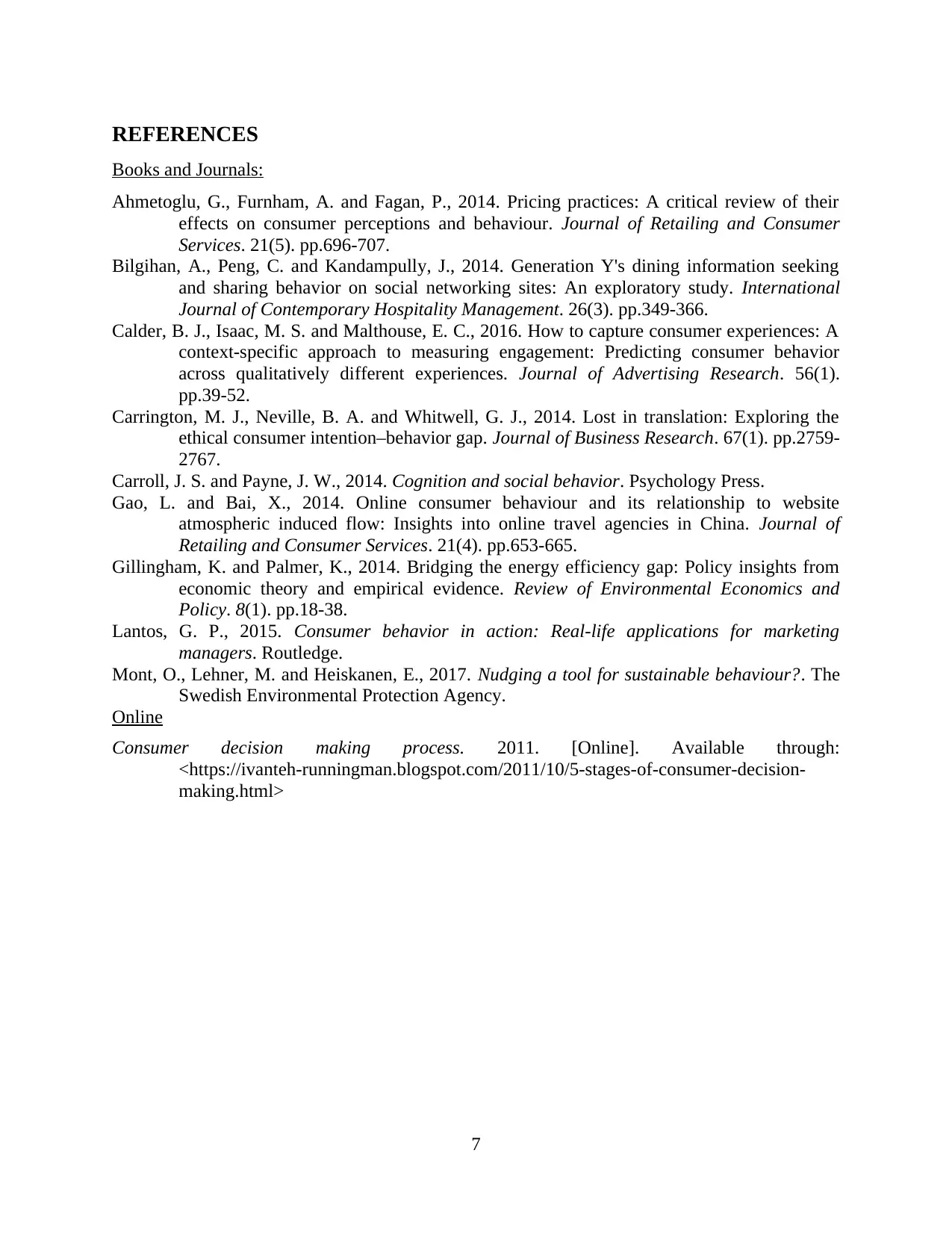
REFERENCES
Books and Journals:
Ahmetoglu, G., Furnham, A. and Fagan, P., 2014. Pricing practices: A critical review of their
effects on consumer perceptions and behaviour. Journal of Retailing and Consumer
Services. 21(5). pp.696-707.
Bilgihan, A., Peng, C. and Kandampully, J., 2014. Generation Y's dining information seeking
and sharing behavior on social networking sites: An exploratory study. International
Journal of Contemporary Hospitality Management. 26(3). pp.349-366.
Calder, B. J., Isaac, M. S. and Malthouse, E. C., 2016. How to capture consumer experiences: A
context-specific approach to measuring engagement: Predicting consumer behavior
across qualitatively different experiences. Journal of Advertising Research. 56(1).
pp.39-52.
Carrington, M. J., Neville, B. A. and Whitwell, G. J., 2014. Lost in translation: Exploring the
ethical consumer intention–behavior gap. Journal of Business Research. 67(1). pp.2759-
2767.
Carroll, J. S. and Payne, J. W., 2014. Cognition and social behavior. Psychology Press.
Gao, L. and Bai, X., 2014. Online consumer behaviour and its relationship to website
atmospheric induced flow: Insights into online travel agencies in China. Journal of
Retailing and Consumer Services. 21(4). pp.653-665.
Gillingham, K. and Palmer, K., 2014. Bridging the energy efficiency gap: Policy insights from
economic theory and empirical evidence. Review of Environmental Economics and
Policy. 8(1). pp.18-38.
Lantos, G. P., 2015. Consumer behavior in action: Real-life applications for marketing
managers. Routledge.
Mont, O., Lehner, M. and Heiskanen, E., 2017. Nudging a tool for sustainable behaviour?. The
Swedish Environmental Protection Agency.
Online
Consumer decision making process. 2011. [Online]. Available through:
<https://ivanteh-runningman.blogspot.com/2011/10/5-stages-of-consumer-decision-
making.html>
7
Books and Journals:
Ahmetoglu, G., Furnham, A. and Fagan, P., 2014. Pricing practices: A critical review of their
effects on consumer perceptions and behaviour. Journal of Retailing and Consumer
Services. 21(5). pp.696-707.
Bilgihan, A., Peng, C. and Kandampully, J., 2014. Generation Y's dining information seeking
and sharing behavior on social networking sites: An exploratory study. International
Journal of Contemporary Hospitality Management. 26(3). pp.349-366.
Calder, B. J., Isaac, M. S. and Malthouse, E. C., 2016. How to capture consumer experiences: A
context-specific approach to measuring engagement: Predicting consumer behavior
across qualitatively different experiences. Journal of Advertising Research. 56(1).
pp.39-52.
Carrington, M. J., Neville, B. A. and Whitwell, G. J., 2014. Lost in translation: Exploring the
ethical consumer intention–behavior gap. Journal of Business Research. 67(1). pp.2759-
2767.
Carroll, J. S. and Payne, J. W., 2014. Cognition and social behavior. Psychology Press.
Gao, L. and Bai, X., 2014. Online consumer behaviour and its relationship to website
atmospheric induced flow: Insights into online travel agencies in China. Journal of
Retailing and Consumer Services. 21(4). pp.653-665.
Gillingham, K. and Palmer, K., 2014. Bridging the energy efficiency gap: Policy insights from
economic theory and empirical evidence. Review of Environmental Economics and
Policy. 8(1). pp.18-38.
Lantos, G. P., 2015. Consumer behavior in action: Real-life applications for marketing
managers. Routledge.
Mont, O., Lehner, M. and Heiskanen, E., 2017. Nudging a tool for sustainable behaviour?. The
Swedish Environmental Protection Agency.
Online
Consumer decision making process. 2011. [Online]. Available through:
<https://ivanteh-runningman.blogspot.com/2011/10/5-stages-of-consumer-decision-
making.html>
7
1 out of 10
Related Documents
Your All-in-One AI-Powered Toolkit for Academic Success.
+13062052269
info@desklib.com
Available 24*7 on WhatsApp / Email
![[object Object]](/_next/static/media/star-bottom.7253800d.svg)
Unlock your academic potential
Copyright © 2020–2025 A2Z Services. All Rights Reserved. Developed and managed by ZUCOL.





